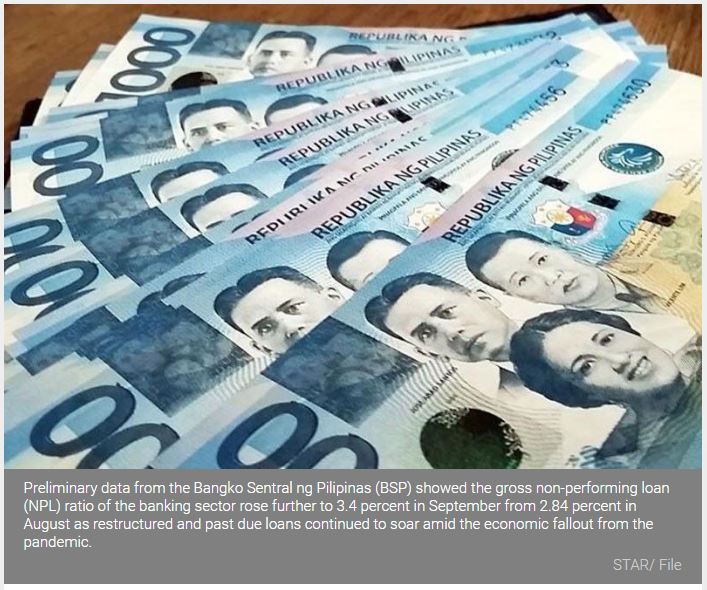Philippines: Bad loans ratio highest in 7 years
MANILA, Philippines — Soured loans of Philippine banks continued to pick up for the ninth straight month, hitting the highest level in more than seven years due to the impact of the COVID-19 pandemic.
Preliminary data from the Bangko Sentral ng Pilipinas (BSP) showed the gross non-performing loan (NPL) ratio of the banking sector rose further to 3.4 percent in September from 2.84 percent in August as restructured and past due loans continued to soar amid the economic fallout from the pandemic.
This was the highest gross NPL ratio since the 3.41 percent recorded in July 2013.
BSP director for Supervisory Policy and Research Department Veronica Bayangos said the Philippine banking system’s asset quality continues to weaken through higher NPL ratio and provision for loan losses due to the impact of the pandemic.
“However, what we should be mindful of in this particular development is that the provisions for loan losses has also increased,” Bayangos said during the virtual 58th annual meeting and conference of the Philippine Economic Society (PES).
The bad loan ratio of the banking industry has steadily increased since the 2.16 percent recorded in January.
NPLs or bad debts refer to past due loan accounts where the principal or interest is unpaid for 30 days or more after due date.
Statistics from the central bank showed gross NPLs of the banking industry surged by 60.2 percent to P364.67 billion in end- September from P227.6 billion in the same period last year, while the sector’s total loan book inched up by 1.6 percent to P10.73 trillion from P10.56 trillion.
Data from the central bank showed restructured loans almost tripled to P125.46 billion in end- September from P42.2 billion in the same period last year for a restructured loan ratio of 1.17 percent.
Likewise, past due loans referring to all types of loans left unsettled beyond payment date jumped by 66.3 percent to P511.38 billion from P307.47 billion for a past due ratio of 4.77 percent.
Philippine banks sacrificed earnings by reinforcing allowance for credit losses in anticipation of a sharp rise in bad loans. The industry’s provision for loan losses surged 60 percent to P334.57 billion from P209.07 billion in the same month last year.
Despite the increase, the NPL coverage ratio declined slightly to 91.75 percent in end-September from 91.86 percent a year ago.
A survey conducted by the BSP showed the industry’s NPL ratio is expected to hit 4.6 percent in end-December due to the pandemic.
Bayangos said Philippine banks remain well capitalized with a capital adequacy ratio (CAR) at 13.6 percent, exceeding the 10 percent threshold set by the BSP and eight percent by the Bank for International Standards (BIS).
In its latest outlook, Moody’s Investors Service said global credit conditions would improve overall in 2021 aided by unprecedented fiscal and monetary support in the wake of the COVID-19 crisis.
“However, the initial rapid economic rebound is giving way to a patchier, more tenuous recovery as the pandemic proves hard to contain,” Moody’s said.
The debt watcher warned a premature withdrawal of fiscal support would have a number of credit effects, hurting the economic recovery, deepening the pandemic’s longer-term structural scars on the economy, and creating periods of financial market volatility and tighter credit conditions.
Source: https://www.philstar.com/business/2020/11/11/2055964/bad-loans-ratio-highest-7-years


 English
English




